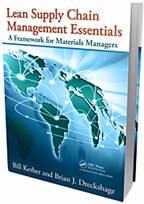 |
(CRC Press: Boca Raton, FL) -- Presenting an alternate approach to supply chain management, Lean Supply Chain Management Essentials: A Framework for Materials Managers (CRC Press, 2011) explains why the traditional materials planning environment, typically embodied by an enterprise resource planning (ERP) system, is an ineffective support system for a company that wants to adopt lean practices. Authors Bill Kerber and Brian Dreckshage begin by defining supply chain management basics, including roles, objectives, and responsibilities, from a traditional framework. Next, they describe lean basics and explore the conflicts between lean and the traditional framework.
…
Add new comment